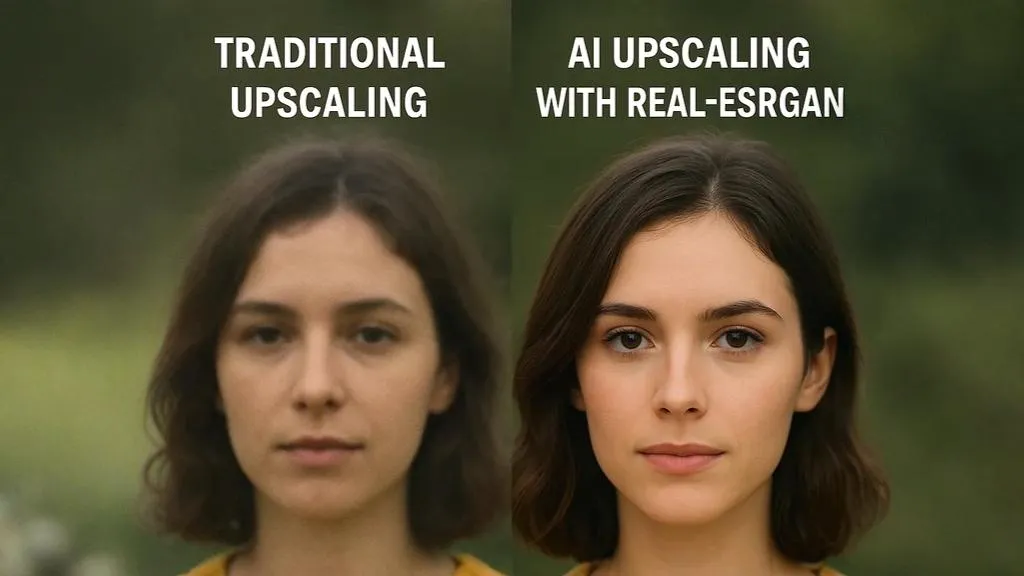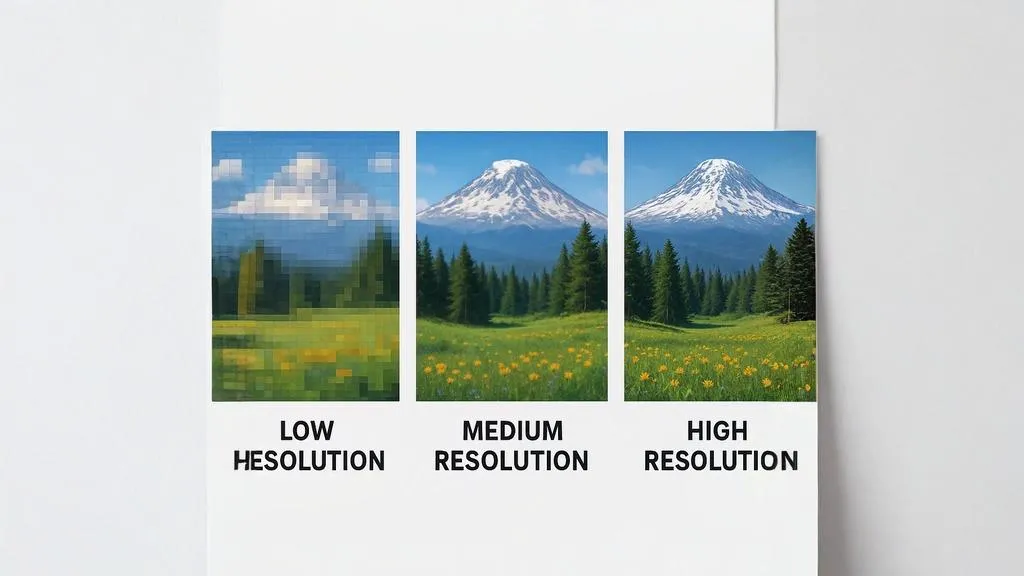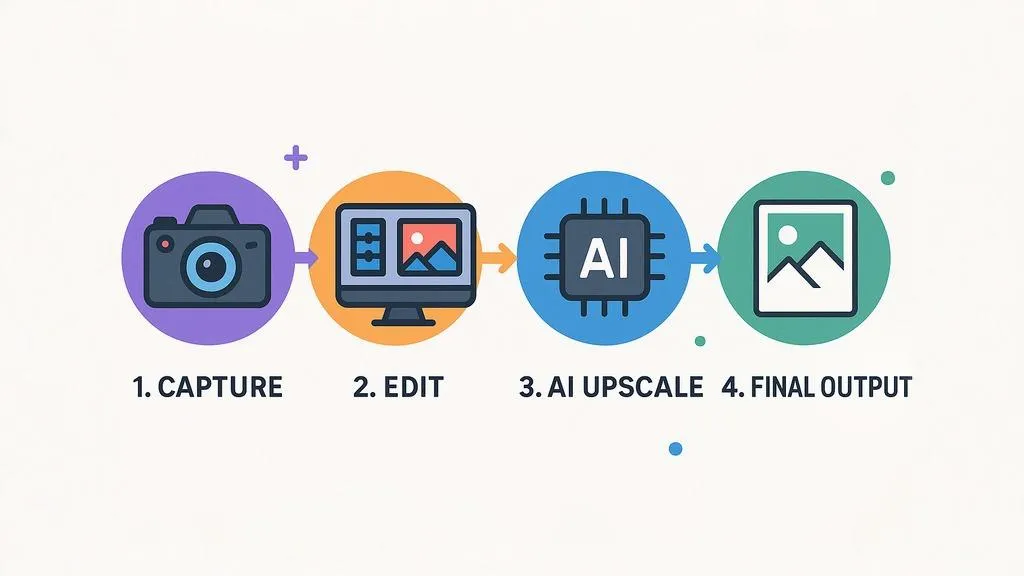At Image AI Upscale, we harness the power of cutting-edge AI technology called Real-ESRGAN to transform your low-resolution images into crisp, detailed high-resolution versions. But what exactly is Real-ESRGAN, and how does it work its magic on your photos?
In this deep dive, we'll explore the technology that powers our upscaling engine, breaking down complex concepts into understandable explanations that don't require an advanced degree in computer science to appreciate.

Simplified representation of the Real-ESRGAN neural network architecture
What is Real-ESRGAN?
Real-ESRGAN stands for Real-world Enhanced Super-Resolution Generative Adversarial Network. That's quite a mouthful, so let's break it down:
- Real-world: Designed to handle actual photos with real-world imperfections like noise and compression artifacts
- Enhanced: Produces results superior to previous technologies
- Super-Resolution: The process of increasing image resolution and quality
- Generative Adversarial Network (GAN): A type of AI architecture where two neural networks work together to achieve better results
Real-ESRGAN is a significant evolution of earlier technologies like SRCNN (Super-Resolution Convolutional Neural Network) and ESRGAN (Enhanced Super-Resolution GAN). It was specifically designed to address the limitations of previous models when dealing with real-world images rather than clean, synthetic data.
The Evolution of AI Image Upscaling
To appreciate how revolutionary Real-ESRGAN is, it helps to understand the evolution of AI-based image upscaling:
1. Traditional Methods (Pre-AI)
Before neural networks, image upscaling relied on mathematical interpolation methods like bicubic, bilinear, and Lanczos. These methods use fixed algorithms to guess the values of new pixels based on surrounding pixels. They struggle with complex details and often produce blurry results.
2. First-Generation AI Methods (SRCNN)
Around 2015, researchers began applying convolutional neural networks to the super-resolution problem. These early models learned patterns from many image pairs (low-res and high-res versions of the same image) to make better predictions about missing details.
3. GAN-Based Methods (SRGAN, ESRGAN)
A significant leap forward came with the introduction of Generative Adversarial Networks for image upscaling. Instead of just minimizing pixel differences, these models use an adversarial approach where one network (the generator) creates upscaled images, and another network (the discriminator) tries to distinguish them from real high-resolution images.
4. Real-World Optimization (Real-ESRGAN)
Previous models worked well on clean, synthetic data but often struggled with real-world photos containing noise, compression artifacts, and blur. Real-ESRGAN specifically addresses these challenges through an improved architecture and training methodology.
How Real-ESRGAN Works: The Technical Deep Dive
For those interested in the technical details, here's how Real-ESRGAN functions:
The GAN Architecture
Real-ESRGAN uses a generative adversarial network architecture consisting of two competing neural networks:
- Generator Network: Takes a low-resolution image and attempts to create a high-resolution version
- Discriminator Network: Tries to distinguish between real high-resolution images and the generator's output
During training, the generator tries to create images so realistic that the discriminator can't tell they're upscaled. The discriminator gets better at spotting fakes, which forces the generator to improve further. This adversarial process results in remarkably realistic upscaling.
Training Process and Data
Real-ESRGAN was trained on a massive dataset of paired images. The training process involved:
- Starting with high-quality images
- Creating degraded versions by applying realistic noise, blur, and compression
- Training the network to recover the original high-quality image from the degraded version
Critically, Real-ESRGAN uses a special degradation model that simulates real-world image problems rather than simply downsampling clean images. This makes it much more effective on photographs taken with smartphone cameras, scanned documents, compressed web images, and other common real-world scenarios.
Technical Note: Real-ESRGAN uses a modified U-Net architecture with residual-in-residual dense blocks (RRDB) for its generator. This architecture allows it to maintain both low-level pixel information and high-level semantic information throughout the processing pipeline.
Key Innovations in Real-ESRGAN
Several technical innovations make Real-ESRGAN particularly effective:
- High-order degradation modeling: Simulates complex real-world image degradation including noise, blur, and compression artifacts
- Improved network architecture: Enhanced residual blocks and skip connections that maintain fine detail
- Perceptual loss functions: Optimizes for visual quality rather than just pixel accuracy
- Large-scale training: Trained on diverse datasets to handle various image types
"The key breakthrough in Real-ESRGAN isn't just in the network design, but in the way it models real-world image degradation. By teaching the AI to understand how images naturally degrade, we can more effectively reverse that process."
Real-ESRGAN in Action: The Upscaling Process
When you upload an image to our platform, here's what happens behind the scenes:
- Image Analysis: The system analyzes your image to identify its current resolution, quality level, and potential degradation types
- Pre-processing: Depending on the image characteristics, certain optimizations may be applied to prepare it for the neural network
- Neural Network Processing: The Real-ESRGAN generator processes your image, intelligently adding details and enhancing quality
- Post-processing: Optional refinements may be applied to balance sharpness, reduce artifacts, and optimize the result
- Final Output: You receive your high-resolution image, typically with 2x, 4x, or even 8x the original resolution
The entire process takes only seconds, thanks to our optimized implementation and GPU acceleration.
What Makes Real-ESRGAN Special?
Real-ESRGAN offers several advantages over other upscaling technologies:
Superior Detail Reconstruction
Where traditional methods simply smooth out pixels, Real-ESRGAN can actually reconstruct realistic details. For example, in a portrait, it can enhance eyelashes, skin texture, and hair strands in a way that looks natural rather than artificially sharpened.
Handling of Real-World Degradation
Many AI upscalers work well on clean test images but struggle with real-world photos. Real-ESRGAN was specifically designed to handle compression artifacts, sensor noise, and other common issues found in everyday photographs.
Content Awareness
The neural network has learned patterns from millions of images, giving it a form of "understanding" about what different objects and textures should look like. It knows that grass should have a certain texture, faces should have certain features, and text should have clean edges.
Balance of Sharpness and Naturalness
Some upscaling methods produce results that are either too soft or artificially over-sharpened. Real-ESRGAN strikes a balance, enhancing details without introducing the unnatural "digital" look that plagues many enhancement tools.
Practical Applications of Real-ESRGAN
This powerful technology has numerous real-world applications:
Photography Enhancement
Photographers can breathe new life into older, lower-resolution images or enhance details in cropped photos. This is particularly valuable for printing large formats from digital images.
Historical Image Restoration
Real-ESRGAN is exceptionally good at restoring old photographs, enhancing details while maintaining the authentic character of the original image.
E-commerce and Product Photography
Online retailers can dramatically improve product images, showing fine details and textures that increase customer confidence and potentially boost conversion rates.
Content Creation
Graphic designers, content creators, and social media professionals can repurpose and enhance existing visual assets for new high-resolution applications.
Document and Text Enhancement
Real-ESRGAN can improve the legibility of scanned documents, making text crisper and more readable.
Case Study: A museum client used our Real-ESRGAN technology to enhance their digital archive of historical photographs from the early 1900s. The enhanced images revealed details that were previously invisible, providing new insights for historians while making the collection more engaging for public display.
Limitations and Ethical Considerations
While Real-ESRGAN is powerful, it's important to understand its limitations and the ethical considerations around its use:
Not Actually "Recovering" Information
It's crucial to understand that AI upscalers like Real-ESRGAN don't actually "recover" information that isn't present in some form in the original image. Rather, they make educated guesses about what high-resolution details would likely exist based on patterns learned from millions of images.
Potential for Detail Fabrication
In some cases, the system might add details that weren't present in the original. While usually realistic, these details may not represent the actual reality of the original scene. This is particularly important to consider for forensic or documentary applications.
Varying Results by Content Type
The model performs better on content types that were well-represented in its training data. Natural scenes, portraits, and common objects typically upscale better than rare, unusual, or highly technical imagery.
The Future of AI Image Upscaling
The field of AI image enhancement continues to evolve rapidly. Here are some developments we're excited about:
Content-Specific Models
More specialized models trained specifically for certain content types (faces, text, medical imaging, etc.) could provide even better results for specific applications.
Greater Preservation of Original Intent
Future models may get better at distinguishing between actual image degradation and intentional artistic choices, preserving the latter while enhancing the former.
Integration with Other AI Technologies
Combining super-resolution with other AI capabilities like object recognition, style transfer, or color enhancement could lead to even more powerful image transformation tools.
Real-Time Processing
As hardware and algorithms continue to improve, we may soon see Real-ESRGAN-quality upscaling in real-time applications like video streaming or live photography.
Conclusion
Real-ESRGAN represents a remarkable achievement in applied artificial intelligence. By leveraging deep neural networks trained on vast datasets, it can transform low-resolution, degraded images into crisp, detailed high-resolution versions in ways that were impossible just a few years ago.
At Image AI Upscale, we're proud to make this cutting-edge technology accessible to everyone. Whether you're a professional photographer, a digital archivist, an e-commerce store owner, or just someone looking to enhance old family photos, our implementation of Real-ESRGAN can help you achieve remarkable results.
Ready to see what Real-ESRGAN can do for your images? Try our upscaling tool today and experience the difference for yourself.
Have questions about the technology or specific use cases? Contact our team for personalized assistance.


